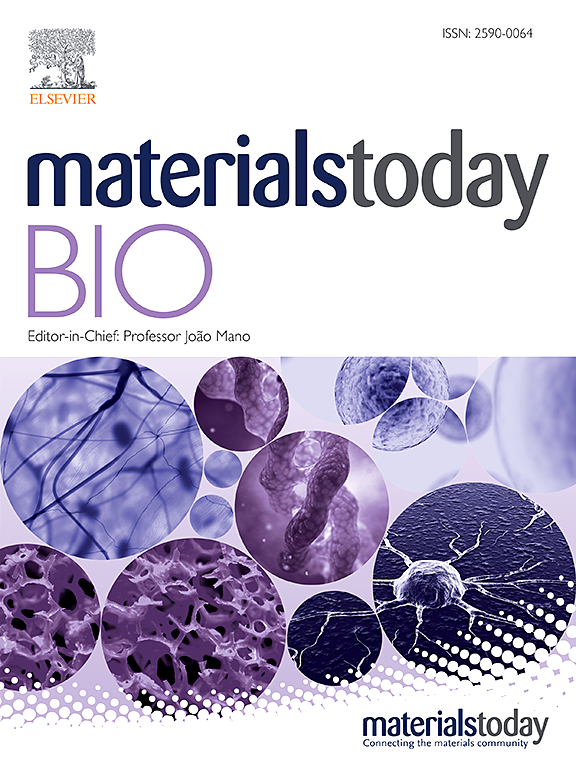Enhanced hydrogel loading of quercetin-loaded hollow mesoporous cerium dioxide nanoparticles for skin flap survival
IF 8.7
1区 医学
Q1 ENGINEERING, BIOMEDICAL
引用次数: 0
Abstract
Flap techniques are indispensable in modern surgery because of their role in repairing tissue defects and restoring function. Ischemia-reperfusion and oxidative stress-induced injuries are the main causes of flap failure. Oxidative stress exacerbates cell damage through the accumulation of reactive oxygen species (ROS), thereby affecting flap function and survival. Effective management of these factors is essential for improving flap survival and post-operative recovery. In this study, we utilized hollow mesoporous cerium dioxide nanoparticles loaded with quercetin, which were later loaded into a light-cured double cross-linked hydrogel (HQu@BC) and injected into the flap site to activate macrophage reprogramming to maintain local ROS homeostasis and reduce inflammation. Quercetin scavenges ROS and reduces mitochondrial oxidative stress due to its intrinsic reducing structures such as catechols, carbon-carbon double bonds, and hydroxyl synergistic mesoporous cerium dioxide nanoparticles, and inhibits inflammation by suppressing M1 macrophage polarization. This system continuously regulates ROS levels, kills bacteria and ultimately reduces inflammation, thereby creating a favorable microenvironment for flap survival. This innovative injectable composite nanoparticle hydrogel material has anti-inflammatory, antioxidant, antimicrobial, and healing-promoting properties, providing a new approach to improving the success of flap surgery.

槲皮素负载的中空介孔二氧化铈纳米颗粒对皮瓣存活的增强水凝胶负载。
皮瓣技术在现代外科手术中具有修复组织缺损和恢复功能的重要作用。缺血再灌注损伤和氧化应激损伤是皮瓣衰竭的主要原因。氧化应激通过活性氧(ROS)的积累加重细胞损伤,从而影响皮瓣功能和存活。有效地处理这些因素对于提高皮瓣存活率和术后恢复至关重要。在本研究中,我们利用负载槲皮素的中空介孔二氧化铈纳米颗粒,随后将其装载到光固化的双交联水凝胶(HQu@BC)中,并注射到皮瓣部位,激活巨噬细胞重编程,以维持局部ROS稳态并减少炎症。槲皮素通过其固有的还原结构,如儿茶酚、碳碳双键和羟基协同的介孔二氧化铈纳米颗粒,清除ROS,减少线粒体氧化应激,并通过抑制M1巨噬细胞极化来抑制炎症。该系统持续调节ROS水平,杀死细菌,最终减少炎症,从而为皮瓣的存活创造有利的微环境。这种创新的可注射复合纳米颗粒水凝胶材料具有抗炎、抗氧化、抗菌和促进愈合的特性,为提高皮瓣手术的成功率提供了新的途径。
本文章由计算机程序翻译,如有差异,请以英文原文为准。
求助全文
约1分钟内获得全文
求助全文
来源期刊

Materials Today Bio
Multiple-
CiteScore
8.30
自引率
4.90%
发文量
303
审稿时长
30 days
期刊介绍:
Materials Today Bio is a multidisciplinary journal that specializes in the intersection between biology and materials science, chemistry, physics, engineering, and medicine. It covers various aspects such as the design and assembly of new structures, their interaction with biological systems, functionalization, bioimaging, therapies, and diagnostics in healthcare. The journal aims to showcase the most significant advancements and discoveries in this field. As part of the Materials Today family, Materials Today Bio provides rigorous peer review, quick decision-making, and high visibility for authors. It is indexed in Scopus, PubMed Central, Emerging Sources, Citation Index (ESCI), and Directory of Open Access Journals (DOAJ).
 求助内容:
求助内容: 应助结果提醒方式:
应助结果提醒方式:


